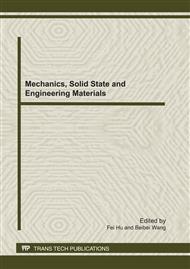[1]
V.M. Fridkin: Photoferroelectrics. Springer, New York, (1979).
Google Scholar
[2]
K. Uchino: Photostrictive Effect in (Pb,La)(Zr,Ti)O3. Ferroelectrics, 64, 1(1985), pp.199-208.
DOI: 10.1080/00150198508018721
Google Scholar
[3]
H.S. Tzou, and C.S. Chou: Nonlinear opto-electromechanics and photodeformation of optical actuators. Smart Mater. and Struct, 5, 2(1996), pp.230-235.
DOI: 10.1088/0964-1726/5/2/012
Google Scholar
[4]
P. Poosanaas, K. Tonooka, and P. Uchino: Photostrictive actuators. Mechatronics 10, 4-5(2000), pp.467-487.
DOI: 10.1016/s0957-4158(99)00073-2
Google Scholar
[5]
C.T. Lin, L. Li, J.D. Mcneill, and et al: Photoconductivity of extrinsic ion-doped PLZT ceramics. J. of Luminescence, 60-61, April(1994), pp.170-174.
DOI: 10.1016/0022-2313(94)90122-8
Google Scholar
[6]
M. Qin, K. Yao, S. Shannigrahi, and et al: Thickness effects on photoinduced current in ferroelectric (Pb0.97La0.03)(Zr0.52Ti0.48)O3 thin films. J. of Appl. Phys., 101, 014104(2007), pp.1-8.
DOI: 10.1063/1.3159894
Google Scholar
[7]
H. Irschik: A Review on Static and Dynamic Shape Control of Structures by Piezoelectric Actuation. Eng. Struct., 24, 1(2002), pp.5-11.
DOI: 10.1016/s0141-0296(01)00081-5
Google Scholar
[8]
D.B. Koconis, L.P. Kollar, and G.S. Springer: Shape control of composite plates and shells with embedded actuators II: desired shape specified. J. of Compos. Mater., 28, 5(1994), pp.459-482.
DOI: 10.1177/002199839402800504
Google Scholar
[9]
D.C. Sun and L.Y. Tong: Modeling of wireless remote shape control for beams using nonlinear photostrictive actuators. Int. J. Solids and Struct., 44, 1(2007), pp.672-684.
DOI: 10.1016/j.ijsolstr.2006.05.013
Google Scholar
[10]
M. Ichiki, Y. Morikawa, Y. Mabune, and et al: Preparation and photo-induced properties of lead lanthanum zirconate titanate multilayers. J. of Phys., D: Appl. Phys., 37, 21(2004), pp.3017-3024.
DOI: 10.1088/0022-3727/37/21/012
Google Scholar
[11]
Z. Luo, L.Y. Tong, J.Z. Luo, and et al: Design of piezoelectric actuators using a multiphase level set method of piecewise constants. J. of Comput. Phys., 228, 7(2009), pp.2643-2659.
DOI: 10.1016/j.jcp.2008.12.019
Google Scholar
[12]
Q.T. Luo, and L.Y. Tong: Constitutive modeling of photostrictive materials and design optimization of microcantilevers. J. of Intell. Mater. Syst. Struct., 20, 12 (2009), pp.1425-1438.
DOI: 10.1177/1045389x09103224
Google Scholar
[13]
Z. Luo, Q.T. Luo, L.Y. Tong, and et al: Shape morphing of laminated composite structures with photostrictive actuators via topology optimization. Compos. Struct., 93, 2(2011), pp.406-418.
DOI: 10.1016/j.compstruct.2010.09.001
Google Scholar
[14]
M.P. Bendsøe, O. Sigmund: Topology Optimization: Theory, Methods, and Applications. Springer, Berlin Heidelberg, (2003).
Google Scholar
[15]
Z. Kang, and L.Y. Tong: Integrated optimization of material layout and control voltage for piezoelectric laminated plate. J. of Intell. Mater. Syst. Struct., 19, 8(2008), pp.889-903.
Google Scholar
[16]
Zhou M, and Rozvany GIN. The COC algorithm, part II: topological, geometry and generalized shape optimization. Comput. Methods Appl. Mech. Eng, 89, 1-3(1991), pp.197-224.
DOI: 10.1016/0045-7825(91)90046-9
Google Scholar
[17]
M.P. Bendsøe, O.Sigmund: Material interpolation schemes in topology optimization. Arch. Appl. Mech,. 69, 9-10(1999), pp.635-654.
DOI: 10.1007/s004190050248
Google Scholar
[18]
J.N. Reddy: Mechanics of Laminated Composite Plates-Theory and Analysis. CRC Press, Boca Raton, (2004).
Google Scholar
[19]
J. Stegman, E. Lund: Discrete material optimization of general composite shell structures. Int, J. Numer. Methods Eng., 62, 14(2005), pp.2009-2027.
DOI: 10.1002/nme.1259
Google Scholar
[20]
K. Svanberg: The method of moving asymptotes-a new method for structural optimization. Int, J. Numer. Methods Eng., 24, 2(1987), pp.359-373.
DOI: 10.1002/nme.1620240207
Google Scholar
[21]
M. Ichiki, Y. Morikawa, Y. Mabune, and et al: Preparation and photo-induced properties of lead lanthanum zirconate titanate multilayers. J. Phys. D: Appli. Phys., 37, 21(2004), pp.3017-3024.
DOI: 10.1088/0022-3727/37/21/012
Google Scholar


